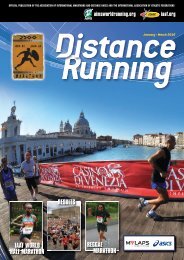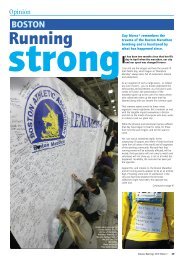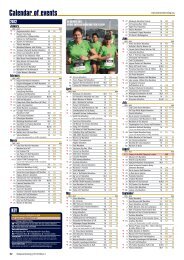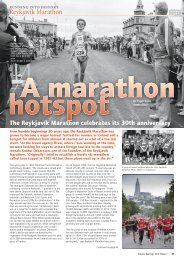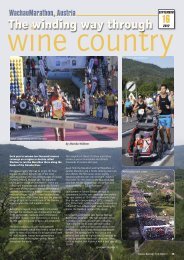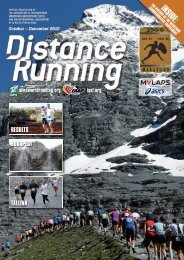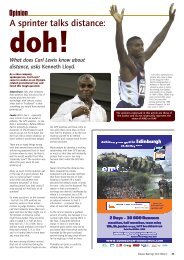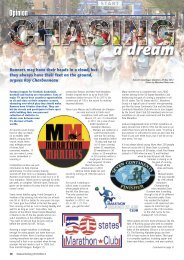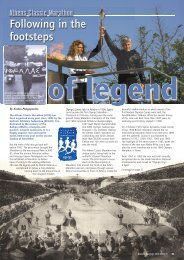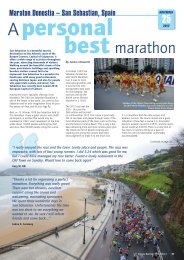Download pdf - Distance Running magazine
Download pdf - Distance Running magazine
Download pdf - Distance Running magazine
You also want an ePaper? Increase the reach of your titles
YUMPU automatically turns print PDFs into web optimized ePapers that Google loves.
for the elite now outstrips that for<br />
all but the best track athletes. Big<br />
wins can be worth $100,000.<br />
Five of the world’s biggest<br />
marathons - Boston, London, Berlin,<br />
Chicago and New York (in their<br />
calendar order) – have formed<br />
themselves into an ad-hoc<br />
organisation, called the World<br />
Marathon Majors. Over a two-year<br />
period, athletes running in these<br />
events can amass points to win<br />
$500,000 each for the overall men’s<br />
and women’s winners.<br />
Klappert sees this latest<br />
development as an opportunity for<br />
IAAF. “Co-operation is the key, and I<br />
believe it is possible. It’s one of our<br />
tasks to promote the sport. In turn,<br />
people have to respect that the IAAF<br />
is the body that sets the<br />
regulations. The IAAF can add<br />
prestige to even the biggest races”.<br />
Mary Wittenberg, race director of<br />
the ING New York City Marathon<br />
points out their group’s appeal. “We<br />
have a combined entry of 300,000<br />
participants, and that’s very<br />
attractive to sponsors”. Despite<br />
huge numbers of participants not<br />
many of these newcomers join an<br />
athletics club, the traditional route<br />
towards achieving higher levels of<br />
performance. Wittenberg agrees.<br />
She sees local race organisation as<br />
the equivalent of a club system,<br />
extending the New York Road<br />
Runners’ reach beyond Central Park,<br />
around the Metropolitan area. “We<br />
believe in the club system, in club<br />
races. The idea of club running<br />
really helps our sport. We need to<br />
get our star runners to stay out<br />
there, meeting the masses, signing<br />
autographs, inspiring everyone<br />
else”.<br />
Dave Bedford, race director of the<br />
Flora London Marathon, sees it a<br />
little differently: “The world has<br />
changed, the club system isn’t as<br />
strong. What you do get is hundreds<br />
and thousands of people talking<br />
online, swapping experiences,<br />
getting advice. A virtual club, if you<br />
like”.<br />
East African runners’ increasing<br />
domination of long distance is seen<br />
as one reason for an alarming<br />
decline in elite running in other<br />
countries. Even stars like Tergat and<br />
Haile Gebrselassie recognise there<br />
is a problem, “The world has lost<br />
interest in long distance races,<br />
because they are regarded as<br />
competition between Ethiopian and<br />
Kenyan athletes” said Tergat.<br />
Bedford’s answer is to exercise more<br />
control. “We need the right kind of<br />
balance. Where the invitation races<br />
have an advantage over the<br />
championships is we don’t have to<br />
be an African Championship. We<br />
can limit their involvement, in order<br />
to nurture our own runners”.<br />
Wittenberg says, “We need to<br />
personalise the winners. Paul Tergat<br />
came to the New York stock<br />
exchange, and he impressed<br />
everybody. And Jelena Prokupcuka<br />
(of Latvia, who won the New York<br />
women’s race), she’s so cute, we<br />
paid for her to have English lessons.<br />
There are many more great athletes<br />
than promotional spots in our<br />
marathons. Someone who comes<br />
across well is highly sought after”.<br />
But the USA is also one of the few<br />
countries to have set up a system<br />
(of elite training camps) to attempt<br />
to counter African dominance. Two<br />
Olympic medals in the marathon<br />
suggests it could be working.<br />
Wittenberg says that New York<br />
wants to contribute to that, even if<br />
they were late starters in the charity<br />
stakes. “We never used to have a<br />
charity programme, but last year, we<br />
raised a million dollars for a public<br />
schools programme that introduces<br />
youngsters to running”.<br />
IAAF road running competitions<br />
have suffered several false starts.<br />
The World Cup marathon, World<br />
Ekiden Championships, and World<br />
Half-Marathon Championships were<br />
all abandoned. To replace them the<br />
World Road <strong>Running</strong><br />
Championships will be held for the<br />
first time in Hungary on 8 October.<br />
Klappert says, “We chose a different<br />
name, because we want to integrate<br />
the championships into existing<br />
events but we need to sort out the<br />
problems of conflicting sponsors,<br />
etc”.<br />
The partnership between the World<br />
Marathon Majors and the IAAF, says<br />
Klappert, “is the beginning of<br />
structuring the sport better. This is<br />
the first tier, but we need a second<br />
tier, then a third. And we also need<br />
promotion and relegation, otherwise<br />
the idea won’t stay alive.”<br />
Pat Butcher is athletics<br />
correspondent for the Financial Times<br />
and author of The Perfect <strong>Distance</strong>:<br />
Ovett & Coe - The Record Breaking<br />
Rivalry (Phoenix Sport)<br />
A longer version of this article first<br />
appeared in the IAAF Magazine,<br />
issue 1, 2006<br />
DISTANCE RUNNING July – September 2006<br />
11



